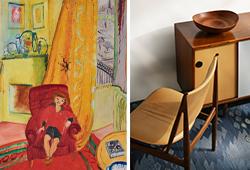Lena Cronqvist
"Dansen"
Signed L. Cronqvist and dated -84. Camvas 172 x 160 cm.
Saleroom notice
Correct date is -84.
Provenance
Galerie Belle, Västerås.
Sivert Oldenvi Collection
Exhibitions
Galleri F15, Moss, Norge, "Lena Cronqvist, January 1987.
"Lena Cronqvist retrospektivt och aktuellt", Konstakademien, Stockholm; Västerås Konstmuseum; Galerie Belle, Västerås; Länsmuseet Gävle; Skövde Konsthall; Västerbottens museum, Umeå; Sundsvalls museum.
Nordens hus, Reykjavik, "Lena Cronqvist", 18 June, 1988.
Värmlands museum, "Lena Cronqvist retrospektivt", 18 January, 1992.
Liljevalchs Konsthall, Stockholm, "Lena Cronqvist", 1994, cat. no. 135.
Literature
Sveriges Allmänna konstförening, "Lena Cronqvist", 1997, utställningskatalog, p. 45.
More information
Lena Cronqvist has consistently and curiously explored what it truly means to be human throughout her entire career as an artist. She has depicted humanity in its most vulnerable situations, from the defenseless newborn to the elderly man on his deathbed. In between, she has sculpted with color and painted the children's play, the clumsy attempts at tenderness by adults, and their longing for love. Using herself as a model, she has questioned the self and the individual's role in relation to the collective.
Cronqvist possesses a unique ability to blur and blend the boundaries between the inner space and the external reality, personal experience and general historical narratives, the highly personal and the universal. Over the years, there has also been an ironic tone in the artist's body of work, as if Cronqvist is keen to show that what she creates are ultimately just images and that reality exists beyond them.
In 1984, Cronqvist saw two dance performances by the German choreographer Pina Bausch and her troupe Wuppertal Tanztheater when they visited Stockholm. The encounter with dance and the total experience it provided for Cronqvist was decisive for a series of new paintings. Moving from depicting isolation and individuality, these works involved an exploration of interaction, where figures draw closer to each other, touch each other, dance, and kiss. In the current painting, "The Dance," we meet a dancing woman with six onlookers who respond to the woman's movement in various ways.
Since her debut in 1965 at Galerie Pierre in Stockholm, Lena Cronqvist has uncompromisingly and consistently continued to approach the human mystery, both in painting and, later, in sculpture.
Artist
Lena Cronqvist is born and raised in Karlstad. Her interest for the arts came early in her life, and she spent the first year of her studies in England, near Bristol’s Art School. Upon her arrival back in Sweden, Cronqvist began a short-lived education at Konstfack, leaving to study painting at the Royal Academy of Fine Arts. When examining Lena Cronqvist's painting, it delves into "painting" in its more traditional sense. She is indeed a painter in the grand modern tradition, frequently turning to Edvard Munch and Francis Bacon’s art as inspirational sources. Yet she also had numerous art historical references and a deep love for the craft. Cronqvist excelled as a colourist, finding harmony in the most unusual colour combinations – few have managed to paint warmth and cold successfully at the same time. Her subject matter is often perceived as challenging and overly private by many. She often models herself for her art, posing in mundane situations imbued with a sharp psychological character. Her “Modonna-pictures” from the 1970s are a good example of this. She turns our gaze away from the conventional, notably in her portrayal and depiction of girls, which is fascinating. Cronqvist depicts these girls as ugly, simple, and altogether uncomfortable – a great contrast to how woman were normally portrayed in art. In more recent years, Lena Cronqvist has studied the effect of aging, using herself as a study. Moreover, Cronqvist is a very successful sculptor, and several of her works in bronze have been sold great sums in the auction world. She is also gifted in graphic productions, of which “Strindbergsmappen” is the most well-known. Among her most renowned works is "The Betrothal," a paraphrase of Jan van Eyck's symbol-laden painting "The Arnolfini Portrait." In Cronqvist's reinterpretation, artist and husband Göran Tunström are the main characters, with equally weighty symbolism but carrying entirely different meanings. Where van Eyck's painting features a loyal dog, Cronqvist replaces it with a cat—a symbol of independence.
Read more




































































